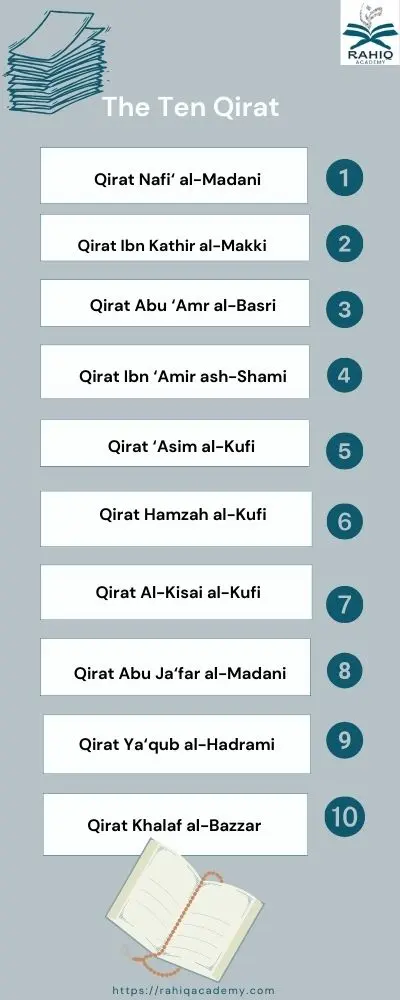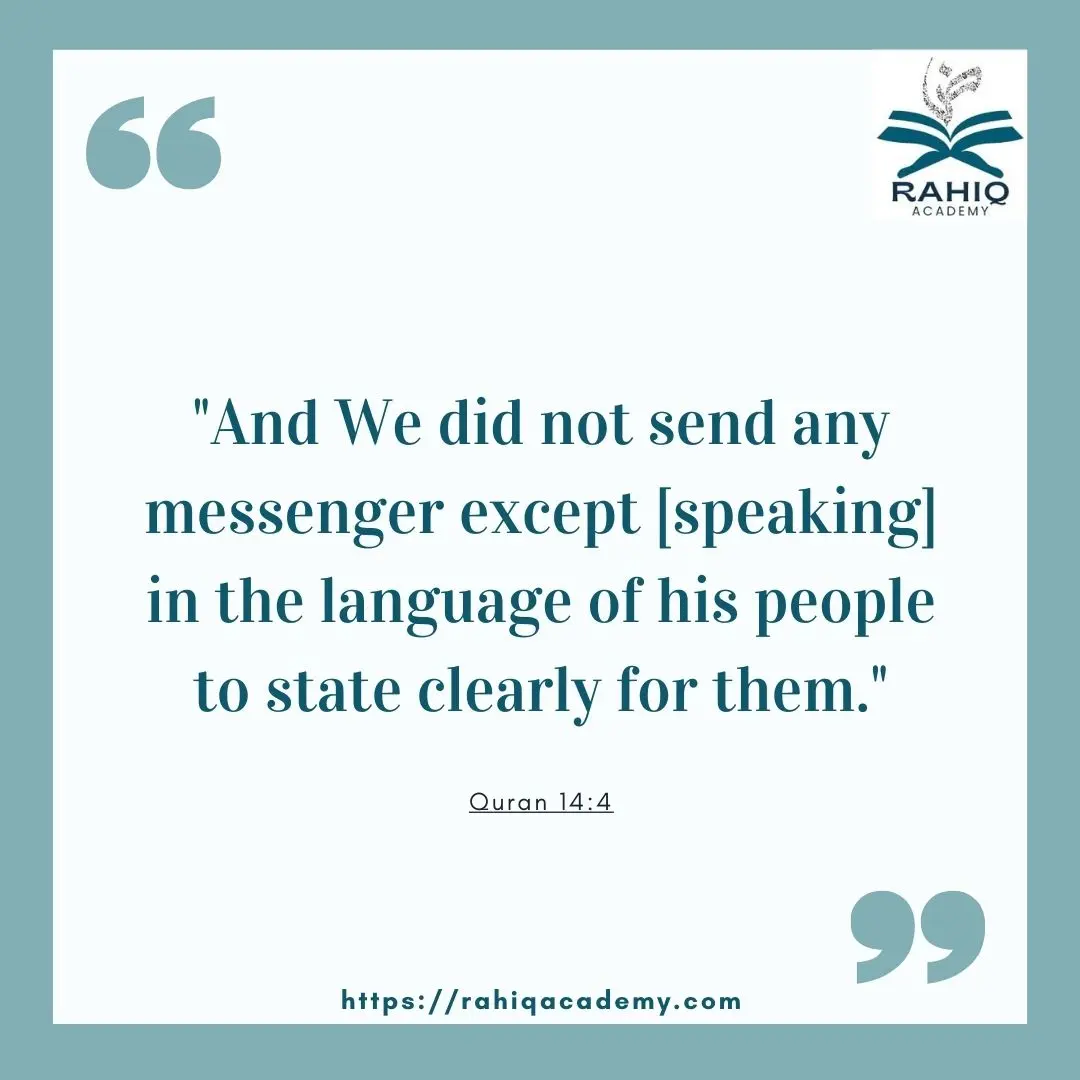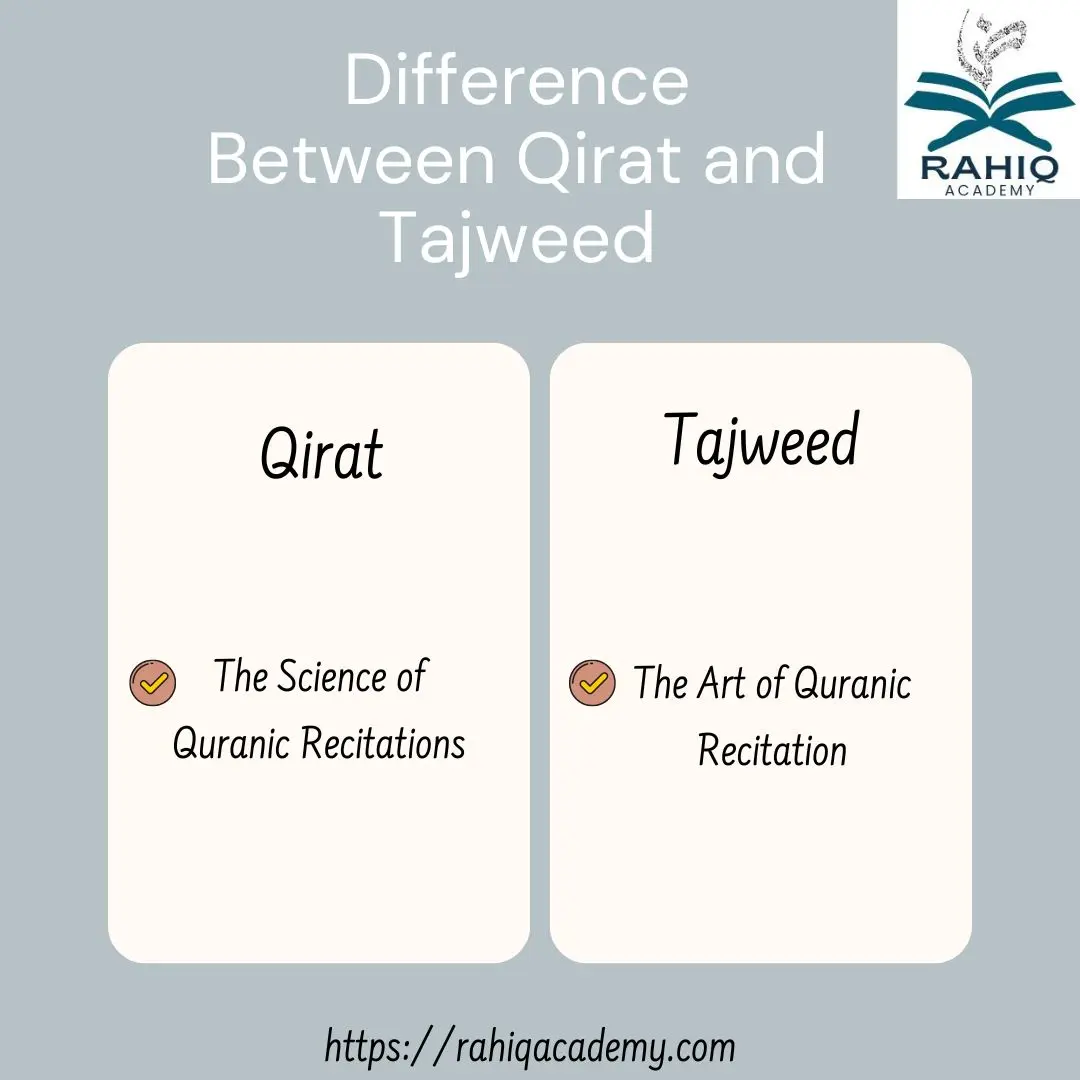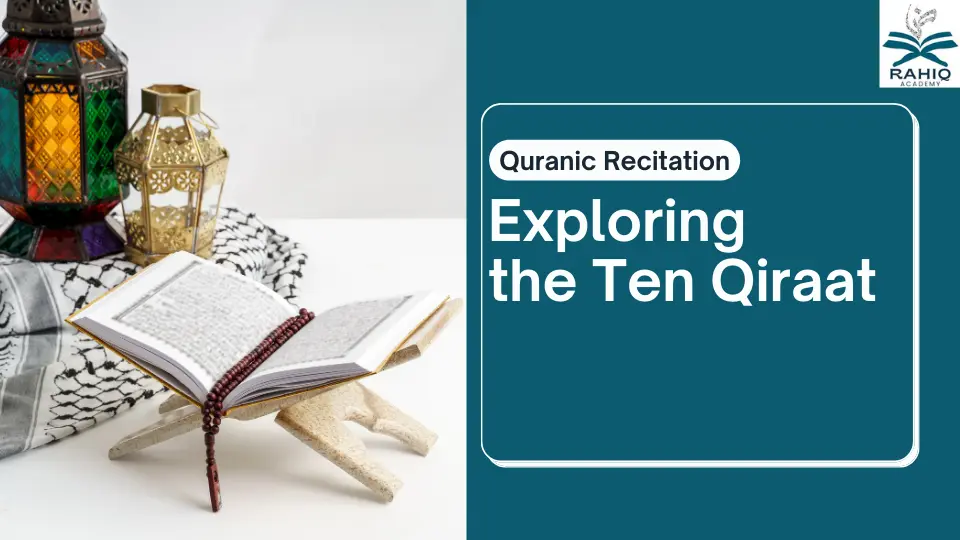The Holy Quran, has been preserved through generations not only in its written form but also through a rich oral tradition. At the heart of this tradition lies the concept of “Qiraat” , which refers to the different authenticated methods of reciting the Quran. Among these, the Ten Qiraat hold a special place in Islamic scholarship and practice.
The Prophet Muhammad (peace be upon him) said:
“Indeed, this Quran has been revealed in seven ahruf (styles), so recite whatever is easier from it.”
This hadith lays the foundation for understanding the diversity in Quranic recitation
What Is Qirat in Islam?
Qirat in Islam signifies the different authentic modes of reciting the Quran, as transmitted by the Prophet Muhammad ﷺ. Each Qirat represents a unique linguistic and phonetic style that reflects the diverse dialects of the early Muslim community. This diversity was divinely sanctioned to facilitate the Quran’s understanding and memorization across various tribes.
The Prophet Muhammad ﷺ highlighted the importance of intentions in worship, which is foundational in the study of Qirat:
“إِنَّمَا الْأَعْمَالُ بِالنِّيَّاتِ، وَإِنَّمَا لِكُلِّ امْرِئٍ مَا نَوَى…”
“Actions are judged by intentions, and every person will get the reward according to what he has intended…”
(Sahih Bukhari, Hadith 1)
Studying Qirat is a means to maintain the integrity of the Quranic recitation and to honor the intention behind preserving the Quran as it was revealed.
What Is Qirat in the Quran?
Qirat in the Quran refers to the different authenticated styles of recitation that were revealed to the Prophet Muhammad ﷺ to accommodate the linguistic diversity of the Arab tribes. These modes are known as the Seven Ahruf (أحرف), which provided flexibility in pronunciation and ease of memorization for different communities.
The Prophet ﷺ said:
“إِنَّ هَذَا الْقُرْآنَ أُنْزِلَ عَلَى سَبْعَةِ أَحْرُفٍ، فَاقْرَءُوا مَا تَيَسَّرَ مِنْهُ”
“Indeed, this Quran has been revealed in seven Ahruf, so recite what is easy for you from it”
(Sahih Bukhari, Hadith 4992)
This hadith emphasizes the divine wisdom in allowing various recitation styles, ensuring that the Quran remains accessible to all, regardless of their linguistic background.
Types of Qirat in Islam

Islamic tradition recognizes several Qirats, categorized into Seven, Ten, and Fourteen Qirats, each attributed to a renowned reciter who mastered that particular method.
The Seven Qirats (القراءات السبع)
- Qirat Nafi‘ al-Madani (قِراءة نافع المدني)
- Narrated by: Warsh and Qalun
- Qirat Ibn Kathir al-Makki (قِراءة ابن كثير المكي)
- Narrated by: Al-Bazzi and Qunbul
- Qirat Abu ‘Amr al-Basri (قِراءة أبو عمرو البصري)
- Narrated by: Al-Duri and Al-Susi
- Qirat Ibn ‘Amir ash-Shami (قِراءة ابن عامر الشامي)
- Narrated by: Hisham and Ibn Dhakwan
- Qirat ‘Asim al-Kufi (قِراءة عاصم الكوفي)
- Narrated by: Hafs and Shu’bah
- Qirat Hamzah al-Kufi (قِراءة حمزة الكوفي)
- Narrated by: Khalaf and Khallad
- Qirat Al-Kisai al-Kufi (قِراءة الكسائي الكوفي)
- Narrated by: Al-Duri and Abul Harith
The Ten Qirats (القراءات العشر)
- Qirat Abu Ja‘far al-Madani (قِراءة أبو جعفر المدني)
- Narrated by: Isa bin Wardan and Ibn Jummaz
- Qirat Ya‘qub al-Hadrami (قِراءة يعقوب الحضرمي)
- Narrated by: Ruways and Rawh
- Qirat Khalaf al-Bazzar (قِراءة خلف البزار)
- Narrated by: Ishaq and Idris
The Fourteen Qirats (القراءات الأربع عشر)
- Qirat Al-Hasan al-Basri (قِراءة الحسن البصري)
- Qirat Ibn Muhaysin al-Makki (قِراءة ابن محيصن المكي)
- Qirat Al-A‘mash (قِراءة الأعمش)
- Qirat Ibn Sa‘id al-Shammi (قِراءة ابن سعيد الشامي)
These variations, while preserving the Quran’s meaning, reflect its linguistic richness and provide deeper insights into the Quranic text.
Why Are There Different Styles of Qirat?
The different styles of Qirat exist to accommodate the linguistic diversity among the early Muslim community and to preserve the Quran’s linguistic and phonetic integrity. The Quran was revealed in seven Ahruf, which allowed for variations in pronunciation and dialectical differences. These Qirats were transmitted by the Prophet Muhammad ﷺ to his companions to ensure the Quran was accessible to all, regardless of their linguistic background.
Benefits of Different Qirats:
- Preservation of the Quran: The various Qirats ensure the Quran’s accurate transmission and preservation across generations.
- Linguistic Diversity: The different recitation styles cater to the diverse linguistic backgrounds of the early Muslim community.
- Enrichment of Understanding: The subtle differences in Qirats provide deeper insights into the meanings and nuances of the Quranic text.
What Is Qirat in Islam?
The most popular and widely practiced Qirat is Hafs ‘an ‘Asim (حفص عن عاصم). It is recognized and used by the majority of Muslims worldwide and is the standard recitation style in most Muslim countries. This Qirat is known for its clarity, ease of memorization, and consistent application of Tajweed rules.
Reasons for Its Popularity:
- Global Reach: It is the most commonly printed version of the Quran and is taught in most Quranic schools.
- Historical Influence: The adoption of this Qirat during the Ottoman Empire significantly contributed to its widespread acceptance.
- Ease of Learning: Its linguistic structure is accessible for both native and non-native Arabic speakers.
The Ten Qiraat and Seven Letters

The Seven Letters (Ahruf)
The concept of “Seven Ahruf” refers to the divine allowance for flexibility in the early recitation of the Quran. This facilitation accommodated the diverse dialects and linguistic variations among Arab tribes at the time of revelation.
Allah says in the Quran:
وَمَا أَرْسَلْنَا مِن رَّسُولٍ إِلَّا بِلِسَانِ قَوْمِهِ لِيُبَيِّنَ لَهُمْ
“And We did not send any messenger except [speaking] in the language of his people to state clearly for them.” (Quran 14:4)
This verse underscores the divine wisdom in revealing the Quran in a manner accessible to its initial audience.
The Ten Qiraat
The Ten Qiraat are specific, authenticated methods of reciting the Quran that developed over time. They are based on the oral traditions passed down from the Prophet Muhammad through chains of trusted narrators.
Each of the ten qiraat is named after a renowned reciter who codified the method, such as Naafi’, Aasim, and Ibn Katheer. These qiraat conform to the Uthmanic codex of the Quran while preserving aspects of the linguistic diversity originally allowed by the seven ahruf.
The History of Harf and Qirat of Quran
The history of the Quranic Qiraat is deeply rooted in the early days of Islam. During the time of Prophet Muhammad, the Quran was revealed with allowance for recitation in seven ahruf to accommodate different Arab dialects.
The Prophet’s companions played a crucial role in preserving these recitations. For instance, Ubayy ibn Ka’b, one of the leading reciters among the companions, reported:
كُنتُ فِي المَسْجِدِ فَدَخَلَ رَجُلٌ يُصَلِّي فَقَرَأَ قِرَاءَةً أَنْكَرْتُهَا عَلَيْهِ
“I was in the mosque when a man entered to pray and recited in a way that I disapproved of.”
This hadith illustrates the early awareness of variations in recitation and the importance placed on authentic transmission.
As Islam spread, various centers of Quranic learning emerged, each developing its own style of recitation. By the 2nd and 3rd centuries AH, scholars began to systematically record and classify these recitation methods.
A pivotal moment came when Abu Bakr Ibn Mujahid (d. 324 AH/936 CE) compiled and authenticated seven qiraat in his work “Kitab al-Sab’a” (The Book of Seven).
Later scholars expanded this to ten and fourteen qiraat, with the Ten Qiraat becoming the most widely studied and practiced.
Difference Between Qirat and Tajweed

While both Qirat and Tajweed are essential to Quranic recitation, they serve difference purposes, here’s the defference between Qirat and Tajweed
Qirat: The Science of Quranic Recitations
Qirat encompasses the specific ways of reciting the Quran transmitted through authenticated chains of narrators. It deals with variations in pronunciation, vocalization, and sometimes word choice.
Tajweed: The Art of Quranic Recitation
Tajweed is the set of rules governing the correct pronunciation of the Quran, regardless of which qirat is being recited. It focuses on the proper articulation of each letter, elongation (madd), and rules of pause and continuation (waqf and wasl).
Allah says in the Quran:
وَرَتِّلِ الْقُرْآنَ تَرْتِيلًا
“And recite the Quran with measured recitation.” (Quran 73:4)
This verse emphasizes the importance of proper recitation, which is the domain of tajweed.
FAQ
Q:How Long Does It Take to Learn 10 Qira’at?
A:Learning the Ten Qira’at usually takes 2 to 4 years, depending on the student’s background and dedication.
Q:What Are the 10 Schools of Qirat?
- Nafi‘ from Madinah
- Ibn Kathir from Makkah
- Abu ‘Amr from Basrah
- Ibn ‘Amir from Damascus
- Asim from Kufa
- Hamzah from Kufa
- Al-Kisai from Kufa
- Abu Ja‘far from Madinah
- Ya‘qub from Basrah
- Khalaf from Kufa
Q:What Are the 10 Qirats?
- Nafi‘ transmitted by Warsh and Qalun
- Ibn Kathir transmitted by Al-Bazzi and Qunbul
- Abu ‘Amr transmitted by Al-Duri and Al-Susi
- Ibn ‘Amir transmitted by Hisham and Ibn Dhakwan
- Asim transmitted by Hafs and Shu‘bah
- Hamzah transmitted by Khalaf and Khallad
- Al-Kisai transmitted by Al-Duri and Abu al-Harith
- Abu Ja‘far transmitted by Ibn Wardan and Ibn Jamaz
- Ya‘qub transmitted by Ruways and Rawh
- Khalaf transmitted by Ishaq and Idris
Q:How Long is a Qari Course?
A:AQari course typically takes 2 to 5 years to complete, depending on the student’s prior experience and level of dedication. Beginners may need more time to build foundational skills in Tajweed, while advanced students focusing on multiple Qira’at might progress more quickly.
Q:Can Anyone Become a Qari?
A:Yes, anyone with dedication and patience can work towards becoming a Qari. Key factors for success include regular practice, a skilled teacher, and a solid understanding of Tajweed.
Q:Who is the Best Qari of All Time?
A:There is no single “best” Qari, as many notable reciters have greatly influenced Quranic recitation.
Among the most revered are:
- Sheikh Abdul Basit Abdus Samad: Celebrated for his melodic voice and strong command of Tajweed.
- Sheikh Mahmoud Khalil Al-Husary: Known for his clear and precise style, he recorded the Quran in multiple Qira’at, benefiting students worldwide.
- Sheikh Muhammad Siddiq Al-Minshawi: Renowned for his gentle and soulful recitations that resonate deeply with listeners.
Conclusion
The Ten Qiraat represent a profound aspect of the Quranic tradition, showcasing the meticulous care taken in preserving the divine revelation. Understanding the Qiraat enhances one’s appreciation of the Quran’s linguistic miracle and the depth of Islamic scholarship.
For those interested in deepening their knowledge of the Ten Qiraat, tajweed, and other aspects of Quranic studies, RAHIQ Academy offers comprehensive courses.
our expert instructors and structured curriculum provide an excellent opportunity to master these essential Islamic sciences.
By studying the Ten Qiraat, we not only preserve a vital part of Islamic heritage but also gain a deeper connection to the Quran as it was revealed and recited by the Prophet Muhammad (peace be upon him) and his companions.
Enroll now the best course for the ten Qiraat
May Allah grant us the ability to recite, understand, and implement the teachings of the Quran in our lives. Ameen.




